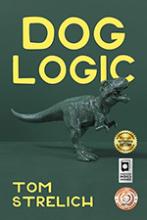Dog Logic
Synopsis
Hertell Daggett is not what he used to be: he’d once been married, he’d once been a physicist, and he’d once been shot in the head in a New Year’s Eve accident. Or possibly the 4th of July, he could never quite remember. The doctors got most of the bullet out, but a few microscopic specks of copper remained floating inside his brain, connecting parts that are no longer connected in the rest of us, filaments of species memory going back to the beginning of time. He knew how animals thought and remembered the singing of dinosaurs, and the dry humor of mastodons, and the rubbery smell of trilobites. He’d once had a future, but he lived now on the outskirts of Bakersfield, California, a damaged caretaker of a run down, failing pet cemetery. And he’s been hearing something.
While Hertell seeks the source of the mysterious sound, a deputy sheriff visiting the grave of his police dog suspects that the pet cemetery is a front for a large-scale meth lab and begins surveillance. The sounds he’s been hearing lead Hertell to an epic discovery when he unearths a time-capsule, actually more of a vast, sprawling time-cavern full of people, many hundreds of them. They’ve been living beneath the pet cemetery since 1963 as part of a long-forgotten Government program to preserve Western civilization in the charred aftermath of a massive nuclear war, presumably triggered by the assassination of President Kennedy – at least that’s what their computer simulation predicted. Hertell informs the time-capsule population that the world did not end in 1963 but in fact had been wobbling on ever since and leads them to the surface where they are immediately descended upon by helicopters, SWAT teams, and drug-sniffing dogs as part of a massive (but mistaken) drug bust. The embarrassing mistake is televised, YouTubed, and streamed for the world to see.
Hertell’s duck-and-cover civilization is initially embraced and celebrated by the modern world – their music, their innocence, their purpose, the miracle of their very existence. And Hertell takes it upon himself to be their protector and shepherd, to lead them gently and lovingly (in stylish casual attire of the early ‘60s) into the astounding, mystifying, and often dismaying modern world. They are his children. They are like one of those lost tribes that stumble out of the Amazonian jungle into civilization, only this time it isn’t the primitives who are overwhelmed by civilization, but very much the other way around, and they will pay for it. Not only do the technologies that allowed them to live happily beneath the surface disrupt the global economy, they also reveal themselves to be unimpressed and indifferent to the machinery of contemporary Government. They’d lived for the past 50 years in complete isolation, and had absolutely no need for it, and specifically no dependency on it. It is simply not part of their lives and they are totally outside its control and the control of basically everybody, everybody but themselves, and that cannot be tolerated. They are denounced as a dangerous, extremist cult and attacked with the full force of the benevolent state. Hertell saves his duck-and-cover civilization, and in the process finds a love he never quite lost and a future he never quite imagined.
Book Cover

Package Purchased
Package Date Range
-
Channel Assignment
1
Interview
TomStrelich.mp3
ISBN13
B076H8X7B2
Fiction / Non-Fiction
Fiction
Genre
Language
Publisher
Format









































